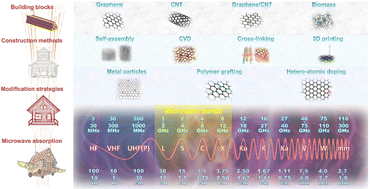Construction and application of carbon aerogels in microwave absorption
Abstract
Electromagnetic pollution that threatens human health, the ecological environment and electronic equipment has been recognized as a serious environmental issue. In view of this, microwave absorbing materials (MAMs) are urgently required in modern society. Compared with traditional MAMs, carbon aerogels have inherent advantages in microwave absorption because of their high porosity and controllable conductive networks. Moreover, they are self-supporting 3D architectures with tailorable shapes, which satisfy most application scenarios. Therefore, carbon aerogels have aroused great interest in recent years and are being developed as promising absorption materials. In this review, we emphasize recent developments in carbon-aerogel-based MAMs constructed with some typical carbon nanomaterials, including graphene, carbon nanotubes and pyrolytic carbon. Their preparation methods, especially some newly developed strategies, are introduced as well as their influence on the structures and properties of aerogels. With a brief analysis of classic microwave absorption processes, we propose the requirements and strategies for modifying carbon aerogels to achieve ideal microwave absorption performance. Finally, we provide comprehensive comparisons of the MA performances of various carbon aerogels that show application potential and set forth the challenges and prospects of this kind of MAM.

- This article is part of the themed collection: 2023 PCCP Reviews


 Please wait while we load your content...
Please wait while we load your content...